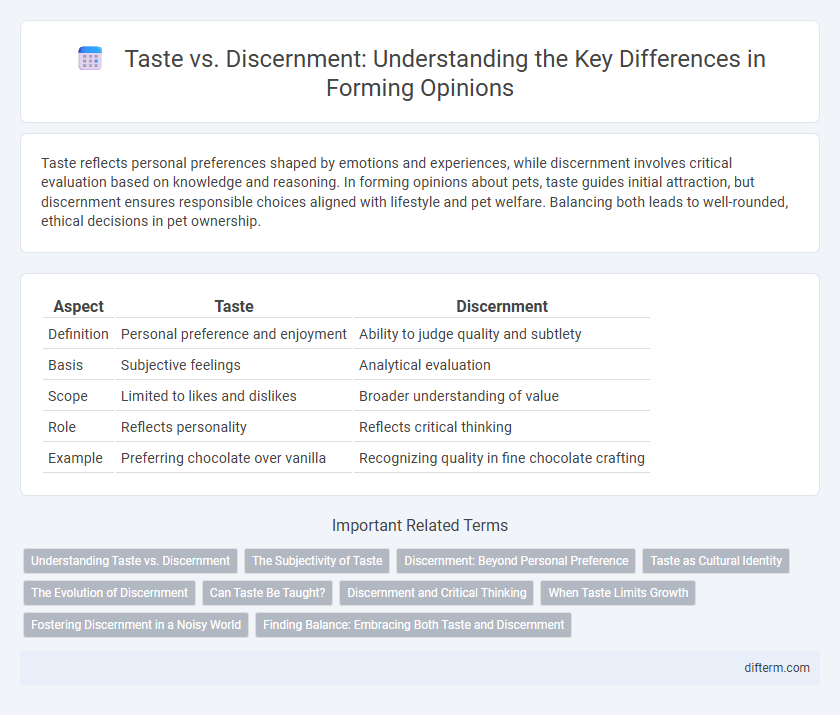Taste reflects personal preferences shaped by emotions and experiences, while discernment involves critical evaluation based on knowledge and reasoning. In forming opinions about pets, taste guides initial attraction, but discernment ensures responsible choices aligned with lifestyle and pet welfare. Balancing both leads to well-rounded, ethical decisions in pet ownership.
Table of Comparison
| Aspect | Taste | Discernment |
|---|---|---|
| Definition | Personal preference and enjoyment | Ability to judge quality and subtlety |
| Basis | Subjective feelings | Analytical evaluation |
| Scope | Limited to likes and dislikes | Broader understanding of value |
| Role | Reflects personality | Reflects critical thinking |
| Example | Preferring chocolate over vanilla | Recognizing quality in fine chocolate crafting |
Understanding Taste vs. Discernment
Taste reflects personal preferences shaped by culture and experience, while discernment involves critical evaluation and an informed understanding of quality. Understanding taste requires acknowledging subjective enjoyment, whereas discernment demands objective analysis and thoughtful judgment. Both play essential roles in appreciating art, cuisine, literature, and broader cultural expressions.
The Subjectivity of Taste
Taste reflects personal preferences shaped by individual experiences and cultural backgrounds, making it inherently subjective. Discernment involves the ability to evaluate qualities with a more informed and often critical perspective, but it cannot completely transcend personal bias. Understanding that taste varies widely emphasizes the importance of embracing diverse opinions rather than seeking absolute standards.
Discernment: Beyond Personal Preference
Discernment transcends mere personal taste by incorporating critical analysis and informed judgment to evaluate quality and value. It involves recognizing subtle nuances and understanding context, which cultivates a deeper appreciation beyond surface-level preferences. This skill enables individuals to make refined choices that reflect both intellect and experience rather than subjective liking alone.
Taste as Cultural Identity
Taste functions as a powerful expression of cultural identity, reflecting collective values, traditions, and social upbringing rather than mere aesthetic preference. It shapes individual and group identities by anchoring people to their cultural heritage through preferences in art, cuisine, fashion, and music. Recognizing taste as culturally constructed challenges the notion of universal standards and highlights its role in fostering community and belonging.
The Evolution of Discernment
Discernment evolves through experience, refining one's ability to distinguish subtle qualities beyond mere taste preferences. Unlike taste, which is often immediate and subjective, discernment develops as a cultivated skill that deepens appreciation and critical judgment. This evolution transforms simple likes and dislikes into informed evaluations, enriching personal and cultural understanding.
Can Taste Be Taught?
Taste can be shaped through exposure, education, and critical reflection, suggesting that it is not entirely innate but can be developed. Discernment involves a deeper understanding and the ability to evaluate nuances, which strengthens with experience and knowledge. Therefore, while initial preferences may be instinctual, taste can indeed be taught and refined over time through deliberate learning.
Discernment and Critical Thinking
Discernment sharpens critical thinking by enabling individuals to evaluate information beyond mere personal taste, fostering informed decisions rooted in logic and evidence. Cultivating discernment involves analyzing underlying factors and distinguishing credible sources from biases, which strengthens intellectual rigor and judgment. Emphasizing critical thinking skills enhances the ability to navigate complex issues, promoting nuanced understanding rather than subjective preference.
When Taste Limits Growth
Taste often confines creative potential by reinforcing comfort zones and familiar patterns, hindering innovation and exploration beyond established preferences. Discernment cultivates critical evaluation and openness to diverse experiences, fostering growth through challenging one's habitual tastes. Embracing discernment over rigid taste expands cognitive flexibility, enabling continuous personal and artistic development.
Fostering Discernment in a Noisy World
Fostering discernment in a noisy world requires nurturing critical thinking skills that filter superficial trends from genuine quality, enabling individuals to appreciate depth rather than mere popularity. Emphasizing thoughtful evaluation over impulsive taste helps cultivate a more refined and informed perspective, essential for navigating the overwhelming influx of information. Discernment transforms passive consumption into active engagement, fostering meaningful connections with ideas, art, and culture.
Finding Balance: Embracing Both Taste and Discernment
Taste shapes immediate preferences influenced by culture and emotion, while discernment involves critical evaluation based on experience and knowledge. Finding balance between taste and discernment enhances decision-making, allowing individuals to appreciate aesthetics while making informed choices. Embracing both qualities cultivates a richer, more nuanced perspective in art, fashion, and daily life.
taste vs discernment Infographic

 difterm.com
difterm.com